During my 20 years at Paulson Bott Press, Pam Paulson and I worked with about 45 artists, about 20 percent of whom have been artists in residence at some point at the Headlands Center for the Arts in the Marin Headlands. Founded in 1982, this international nonprofit arts center has been supporting a wide variety of artists in their creative process for nearly 40 years.
Margaret Kilgallen’s print: Half-Cocked, 1997 Margaret Kilgallen in the Paulson Press Studio, 1997. Photos by Renee Bott
I believe our first Headlands encounter was in 1998, when Heather Tunis, then the development director of the Headlands Center, asked Pam and me to collaborate with the artist Margaret Kilgallen to create a gift print to raise money for the organization. (You can read more about that experience here: Remembering Margaret Kilgallen). I first met sharon maidenberg, who was executive director for Headlands Center from 2010 to 2020 at a fund raiser for the Headlands. sharon’s warmth, energy and enthusiasm for the organization was captivating. Shortly before her departure to take on the position of executive director of the Contemporary Austin in Texas, I caught up with her to chat about her experiences at the Headlands Center.
Artist residency hall the Headland Center for the Arts and the Executive Director’s residence house. Photo by Renee Bott
RB: How did you wind up at Headlands Center for the Arts?
maidenberg: I can’t say that it was intentional. I was a young nonprofit arts administrator at Yerba Buena Center for the Arts in the mid-2000s. A friend of a friend was on one of the Headlands Center’s volunteer committees and asked if I would volunteer. After a couple of years, the then-executive director hired me as associate director. At the time, the staff was still quite small. In 2009, I stepped in as acting director, which I did for a year. We completed a full master plan to focus on the future of the organization. Then the board of directors asked me to become executive director.
Margaret Kilgallen’s Studio at the Headlands Center for the Arts, 1997. Photo courtesy of the Headlands Center for the Arts
RB: What was it like to move in to the executive director’s house at the Headlands Center?
sm: It was an adventure. It was just my partner and me and our dog. Before then, I’d had quite a commute—we were living in Bernal Heights in San Francisco. We thought living in a national park would be temporary. It’s one of the houses originally built in the early 1900s to serve as officers’ quarters for Fort Barry. The artists live in them when they are in residence. They’re quite beautiful. And there is a sublime, slightly eerie, but also magical energy to living here, which is part of the experience.
RB: What are some of your favorite things you’ve experienced here?
sm: Hands down, it’s the people. I feel very fortunate to have been able to run such a mission-focused program. The idea that we can support artists directly with very few strings attached feels like a gift to me. It’s been very gratifying to give artists the things they need—money, space, time, community, food. A vast number of artists have come through—about 1,600—and the organization will be 40 years old soon.
Kota Ezawa works in the studio at the Headlands Center for the Arts. Photo courtesy of the Headlands Center for the Arts.
RB: Tell me more about the Thematic Residency Program that you created for Headlands.
sm: Inspired by our artist-in-residence program, we asked ourselves, what would it look like if we curated a group of artists, thinkers, writers, policymakers, educators, and other experts who are interested in a similar topic or theme and gathered them here at the same time? We bring artists with strong and valuable opinions on certain topics into a room with people who are working in those sectors to consider a particular issue together for about a week. The ultimate goal of the program is to create a deeper understanding and valuing of the role that artists play in society.
Clare Rojas works with Renee Bott at Paulson Bott Press & Clare’s studio at the Headlands. Photo courtesy of Headlands Center Photo courtesy of Paulson Bott Press. for the Arts.
RB: In your new role as executive director of the Contemporary Austin, do you think you’ll be collaborating with some of the artists you’ve known from the Headlands Center?
sm: I hope so. The other thing that’s attractive to me about Austin is that, like the Bay Area, it has a certain flavor, a DNA that is pretty identifiable. So how does an organization reflect the DNA of its region? I’m looking forward to seeing how the Contemporary Austin can move toward becoming much more of a local and regional beacon. The organization has two discrete properties, a downtown museum and a beautiful, large-scale sculpture park that people love in the same way that people love the Marin Headlands. I’m excited to see how we can bring art and open space together in ways that people connect with.
The Marin Headlands, 2020
RB: With the coronavirus pandemic, what does the future look like for nonprofit arts organizations?
sm: It’s very clear that nonprofit arts organizations will have to make some tough choices, because philanthropy is not going to work in the way we hoped it would, at least not in the near future. I think a lot of arts organizations now are thinking about survival: what do we look like after this? And given the anti-racism conversation, what is an arts organization’s responsibility to show up in alignment with its values? There is an opportunity to really rethink what relevance looks like.







